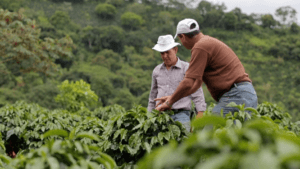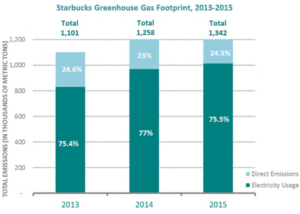Starbucks Coffee Nightmare: Will future mornings be deprived of our favorite drink?

The global warming is threatening coffee production, which is already in a large deficit compared to the constantly rising coffee consumption. As the largest coffee seller in the world, Starbucks is facing significant challenges, yet has already started fighting for sustainability.
“As long as there is coffee in the world, how bad could things be?”― Cassandra Clare, City of Ashes
But, how long will this hold true?
Background and forthcoming challenge
Coffee drinking is one of the most prevalent contemporary habits: more than 400 million cups of coffee are consumed daily in the US only! As more and more people drink coffee across the globe, coffee bean requirements increase each year, yet producers fail to keep up. On the raw material side, coffee drinks are essentially roasted, crushed and brewed coffee beans. The latter are produced in areas around the equator and the key varieties are Arabica – 75% of production (a), Robusta – 25% of production (r), while some areas produce a mixture of the two (m).

Climate change has imposed a serious threat in the production of coffee. Both the increase in the average temperature globally and the shift of the raining seasons destroy larger and larger parts of the farmers’ yields and create favorable conditions for pests and plant diseases. For instance, Brazil and Central America currently used to grow the most popular type of coffee, Arabica, will be unsuitable to the crop by 2050 (International Center for Tropical Agriculture). Globally a 50% decline is predicted over the same period. The most likely outcome would be a drop in quantity and a rise in prices.
This is becoming evident, with the gap between the decreasing production and the increasing consumption has turned negative in the past years, resulting in a ~3.3 million 60kg coffee bean bags deficit. The trend is exacerbating; low sophistication farmers are faced with the unprecedented climate change impact and have no means or knowledge on how to protect their crops.

Starbucks: from small shop to empire to crisis
In its almost 40 years of existence, Starbucks has become the largest global coffee seller and boasts presence in more than 60 countries with a network of ~22,000 stores and a sky-high brand awareness. Throughout the company’s life, best quality coffee produced and brewed with sustainable methods has been a core priority. Thus, the company established detailed quality processes and criteria to make a coffee bean “Starbucks-level” and conducted extensive trainings to the selected farmers.
Climate change is however threatening the company’s core product and operating model, forecasting a doubtful future for our favorite latte and our relaxation spot in the coffee shop next corner. On one hand, higher temperatures destroy the overall yield and hamper, even further, the availability of “Starbucks-level” coffee beans, which results in lower supply for higher prices. On the other hand, new, stricter regulations have forced Starbucks stores and plant to reconsider their environmental footprint, in terms of energy consumption and emissions.
What is Starbucks doing?

Leveraging its consistent profitability and CSR-focused image, Starbucks has heavily invested to counter the aforementioned threats. On climate change, Starbucks focused more on maintaining consistent production levels in terms of quantity and quality:
- Extensive training has been provided since 2004 to coffee bean farmers in the key production areas (e.g. Brazil, Colombia) affected by global warming. Farmers are provided with knowledge and basic tools to better cultivate coffee beans in higher temperatures and through uncommon drought periods.
- Research for durable coffee seeds is the company’s new focus. Starbucks bought a large farm in Costa Rica in 2014 and converted it to a lab, aiming to develop with natural methods new coffee seeds that are more resistant to higher temperatures, lower water supply and do not need extensive maintenance. Additionally, new farming techniques are tested and perfected. All the research provides input in the training conducted to farmers.
On footprint reduction, the company is focusing efforts on energy conservation and the purchase of renewable energy, as more than 80 percent of emissions are attributable to energy for use in stores, offices, and manufacturing plants. The program however has not been particularly effective as Starbucks has, in parallel in 2014, entered the warm food industry.

What could Starbucks do more?
There is significant room for Starbucks to increase impact against the perilous effects of climate change to its business.
- Further expand training to more farmers in more parts of the world that focus on coffee bean production (e.g. mid-Africa, Indonesia) and conduct partnerships with more farmers in areas that will be less affected by the climate change in the coming years – i.e. countries further away from the equator that are currently suitable for the production of coffee (e.g. Myanmar, N. India, Cote d’ Ivoire)
- Expand coffee farming: invest and promote coffee bean production in areas that were not but are currently or are expected to be suitable
- Move-up the supply chain: following the success of the Costa Rica farm, the company should invest in the purchase of farms and conduct its own coffee production
- Change crop focus: currently Starbucks is mostly selling the Arabica coffee blend (75% of production, globally). The production of the crop faces extensive uncertainty in the future and the company should focus on alternative blends, produced from other, more durable crops, potentially derived from a mixture of existing varieties or from new ones, developed by Starbucks
Word count: 851
Sources
- Tackling Climate change, Starbucks corporate website: http://www.starbucks.com/responsibility/environment/climate-change
- Starbucks Exec Warns of Climate Change Impacts on World Coffee Supply; Global Warming is Real: http://globalwarmingisreal.com/2011/10/18/starbucks-exec-warns-of-climate-change-impacts-on-world-coffee-supply/
- Starbucks Responds to Climate Change, with Mixed Results; MIT Technology Review: https://www.technologyreview.com/s/601404/starbucks-responds-to-climate-change-with-mixed-results/
- Coffee; Wikipedia: https://en.wikipedia.org/wiki/Coffee
- The current state of global coffee trade; International Coffee Organization (ICO): http://www.ico.org/monthly_coffee_trade_stats.asp
- A bitter cup: climate change profile of global production of Arabica and Robusta coffee; Springer link: http://link.springer.com/article/10.1007/s10584-014-1306-x



Interesting stuff. I agree with you not the expanding their farming and going up the supply chain. Financially it may not be the best decision but its difficult to disregard the strategic value of securing your sourcing supply. Starbucks has the capital to invest in new technologies and farming practices that the typical coffee farmer doesnt. Sadly. Howard Shultz has publicly stated that starbucks isnt interested in expanding this initiative. I also think coffee is going to eventually migrate to regions away from the equator as temperatures continue to rise. My family actually lives in Colombia’s coffee growing regions and the climate there has changed significantly over the last 20-30 years. But what’s going to happen to those farmers who are displaced by climate change and how much of the responsibility lies with starbucks vs. governments?
Thanks for the post! As an avid tea drinker, it’s interesting for me to see the similarities in the two industries and the problems they face, yet they approach to solving these problems in silos. Do you think there is benefit from public-private partnerships between companies like Starbucks and governments/ agriculture boards to address these issues at a systemic level?
While a lot of these solutions are very promising, they seem pretty long-term. What short-term interventions are they using? I can think of a few:
1. Planting trees for shade/to reduce temperature
2. Planting soil-binding grass to prevent soil erosion
3. Microbiomes (like Indigo Agriculture)
To encourage farmers to adopt new practices that may require investments, Starbucks can put in place long-term contracts that guarantee these farmers an income.
What is the likely hood that new areas will become suitable for coffee bean growth once climates have shifted? Could we see coffee bean growth in North America once the traditional areas are too hot and over utilized?
Interesting post. As a person who cannot live without coffee, I find that Starbucks is not taking this problem seriously. Like you mentioned in your blog, there is a lot more Starbucks could do to face this problem. I think your proposal #3 Moving up the supply chain is the most critical action for Starbucks to take immediately. Instead of relying on farmers to make sustainable changes, why can’t Starbucks partner with them? Starbucks has the potential to help and change the coffee farming industry with their scale – yet they are not.